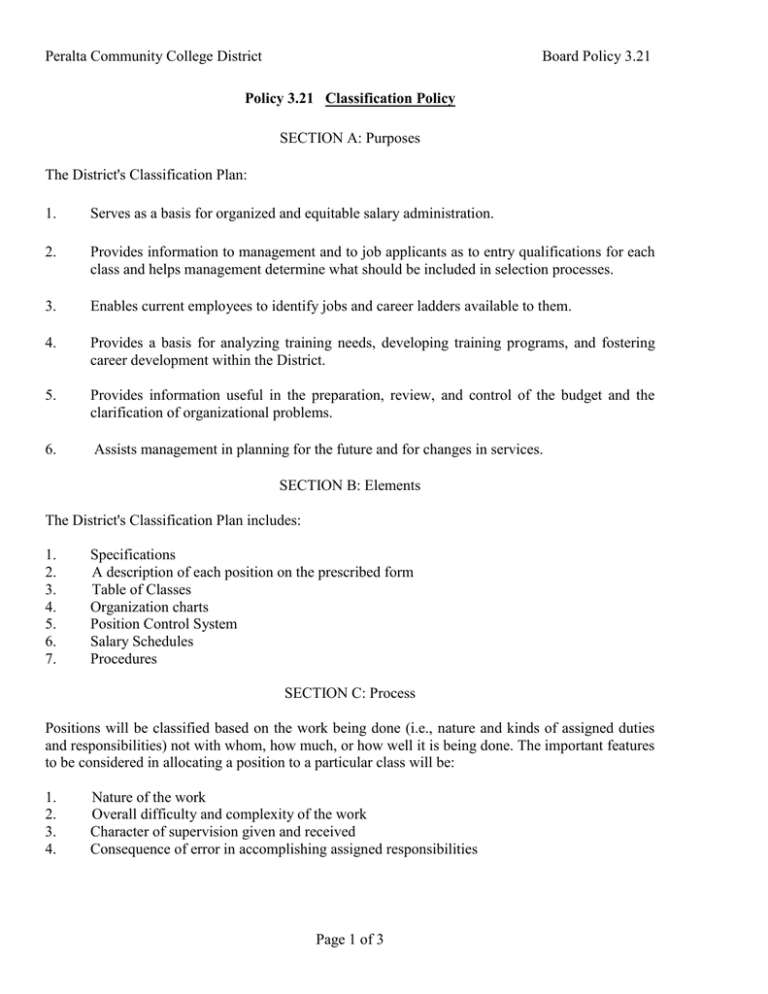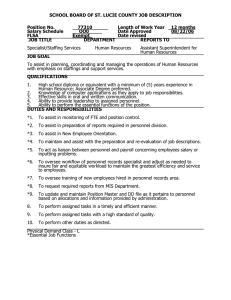BP 3.21
advertisement

Peralta Community College District Board Policy 3.21 Policy 3.21 Classification Policy SECTION A: Purposes The District's Classification Plan: 1. Serves as a basis for organized and equitable salary administration. 2. Provides information to management and to job applicants as to entry qualifications for each class and helps management determine what should be included in selection processes. 3. Enables current employees to identify jobs and career ladders available to them. 4. Provides a basis for analyzing training needs, developing training programs, and fostering career development within the District. 5. Provides information useful in the preparation, review, and control of the budget and the clarification of organizational problems. 6. Assists management in planning for the future and for changes in services. SECTION B: Elements The District's Classification Plan includes: 1. 2. 3. 4. 5. 6. 7. Specifications A description of each position on the prescribed form Table of Classes Organization charts Position Control System Salary Schedules Procedures SECTION C: Process Positions will be classified based on the work being done (i.e., nature and kinds of assigned duties and responsibilities) not with whom, how much, or how well it is being done. The important features to be considered in allocating a position to a particular class will be: 1. 2. 3. 4. Nature of the work Overall difficulty and complexity of the work Character of supervision given and received Consequence of error in accomplishing assigned responsibilities Page 1 of 3 Peralta Community College District Board Policy 3.21 Adding lower level duties to a position, or more duties of the same kind and level, does not justify a higher classification. Problems of excessive workload are properly resolved by redistributing the work, not by reclassifying existing positions. SECTION D: Salary Administration Salaries for each class are negotiated with the appropriate bargaining unit or, in the cases of management and confidential classes, are determined by the Board. The salary for each classified employee is determined by the class to which the employee's position is allocated. All new employees should be hired at the first step of the appropriate salary range. In exceptional situations, the District may approve initial placement at a higher step based on recruitment difficulties or comparable problems. Advancement of an employee through the steps in the salary range is intended as a recognition of the increased proficiency that comes with experience in the District. SECTION E: Definitions 1. Class -- a group of positions for which the duties and responsibilities are sufficiently similar that a) the same official title and minimum qualifications can be appropriately applied to all, and b) the same treatment is appropriate to all with respect to selection and other personnel processes. The same negotiated or Board-determined salary range applies to all positions in a single class. Classes will be defined as broadly as is both feasible and consistent with good personnel practice. Each class is defined in a specification. 2. Position -- a combination of duties and responsibilities assigned by management to be performed by one person. A position may be full or part-time, temporary or permanent, filled or vacant. 3. Position Control -- the numbering system used to identify authorized positions for purposes of recruitment, budgeting, classification and meeting of other organizational needs. 4. Position Description -- a specific description of the major and on-going duties and responsibilities assigned to a single position. A regular minimum number of assigned hours per day, days per week, and months per year will be designated for each position; this information will be considered to be a part of the position description. 5. Series -- two or more classes which are similar in duties and nature of work but which differ in levels of difficulty and responsibility. Classes in a series normally constitute a line of promotion. 6. Specification -- the document that provides for each class: a designated title, a class purpose, a general description of typically assigned duties and responsibilities (examples of typical duties), minimum qualifications (including education, licenses where applicable, experience, knowledge, skills and abilities), and characteristics that distinguish it and its series from other classes and series. Types of specifications include: Page 2 of 3 Peralta Community College District Board Policy 3.21 a. Single class specification: describes only one class. b. Series specification: describes a single series. c. Multi-class specification: describes a group of classes which are comparable in level and kind of work but which differ from one another in terms of specific skill or field of expertise required. 7. Salary schedule -- a document listing negotiated or Board-established salary ranges by class. 8. Class Concept Summary -- a summary of all elements of a specification except the knowledge, skill, and ability qualifications and Examples-of-Typical-Duties sections. Upon approval by the Board of the applicable Class Concept Summary: a. The Chancellor is delegated authority to complete and approve the specification (including Examples-of-Typical-Duties and Knowledge, Skill, and Ability requirements). b. All specifically named classes will be determined to have been established by the Board. c. The Chancellor is delegated authority to establish additional specific classes or series within a multi-class specification or a multi-class series specification. SECTION F: Bi-Lingual Classes Any Class may be modified by the addition of a specific language requirement following the class title. Addition of a bi-lingual requirement constitutes the creation of a new class. SECTION G: Maintenance Assignment of duties and responsibilities to positions is a line management function. Classification of positions is the responsibility of the District Office. The Chancellor is directed to develop procedures and assign responsibilities for implementation of this policy. Source of Law: Approved by Board of Trustees: January 5, 1982 Page 3 of 3

